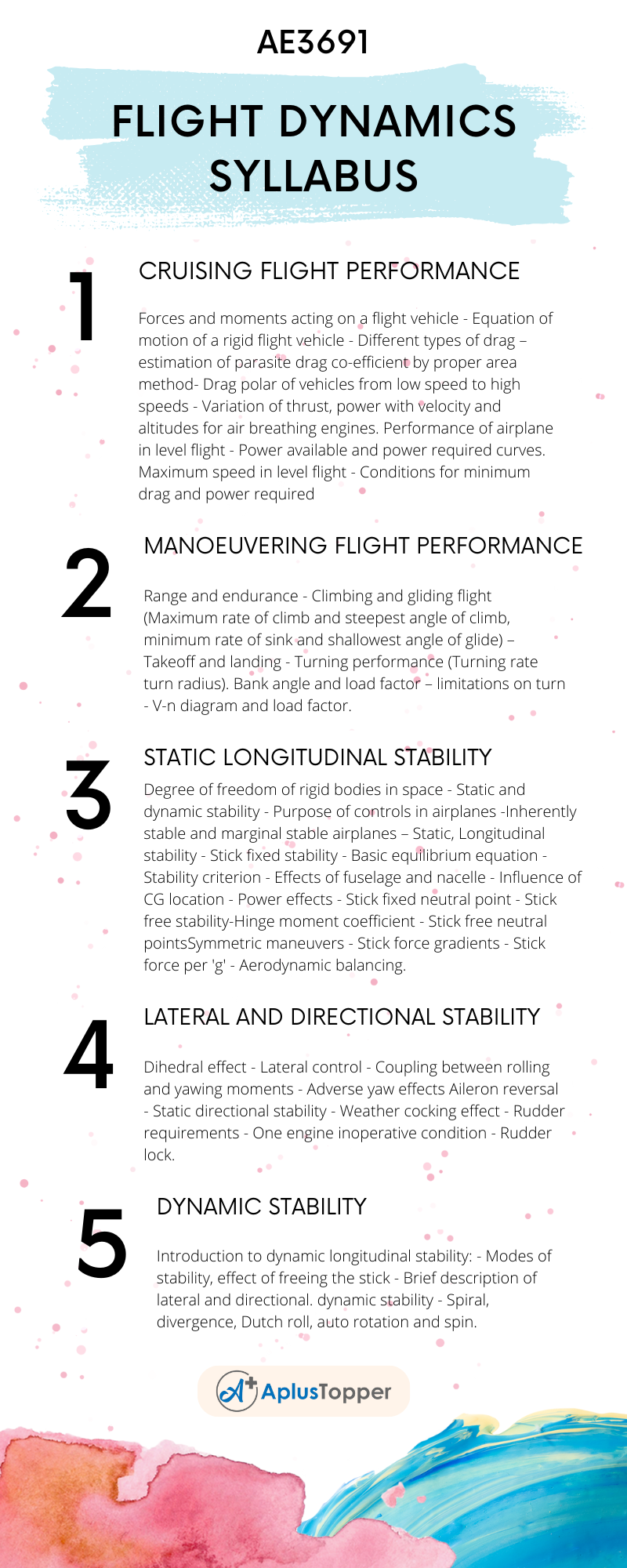Regulation 2021, Anna University Subject code – AE3691 deals with B.E Aeronautical Engineering 3rd year semester VI Flight Dynamics Syllabus. To prepare for challenging subjects in the field of Aeronautics need a detailed syllabus and preparation strategies. In this article, we discuss the Flight Dynamics syllabus.
We intend to provide every topic of the syllabus and content required for academic performance, along with reference books. In this article, AE3691 – Flight Dynamics Syllabus, you will be guided to get an idea of each topic of the syllabus and you can make your preparation strategy, and notes by filtering difficult topics from the different subjects. Then you can concentrate on the topic where you need to focus more. We included all the topics regarding the Aeronautical syllabus. We hope this information is useful to you. Don’t forget to share it with your friends and classmates.
If you want to know more about the syllabus of B.E Computer Science and Engineering connected to an affiliated institution’s under four-year undergraduate degree programme. We provide you with a detailed Year-wise, semester-wise, and Subject-wise syllabus in the following link B.E Aeronautical Engineering Syllabus Anna University, Regulation 2021.
Aim Of Concept:
- Know about the forces and moments that are acting on an aircraft, the different types of drag, drag polar, ISA, variation of thrust, power, SFC with velocity and altitude.
- Have understanding about performance in level flight, minimum drag and power required, climbing, gliding and turning flight, v-n diagram and load factor.
- Knowledge about degrees of stability, stick fixed and stick free stability, stability criteria, effect of fuselage and CG location, stick forces, aerodynamic balancing.
- Understanding about lateral control, rolling and yawing moments, static directional stability, rudder and aileron control requirements and rudder lock.
- Understanding about dynamic longitudinal stability, stability derivatives, modes and stability criterion, lateral and directional dynamic stability.
AE3691- Flight Dynamics Syllabus
Unit I: Cruising Flight Performance
Forces and moments acting on a flight vehicle – Equation of motion of a rigid flight vehicle – Different types of drag –estimation of parasite drag co-efficient by proper area method- Drag polar of vehicles from low speed to high speeds – Variation of thrust, power with velocity and altitudes for air breathing engines. Performance of airplane in level flight – Power available and power required curves. Maximum speed in level flight – Conditions for minimum drag and power required
Unit II: Manoeuvering Flight Performance
Range and endurance – Climbing and gliding flight (Maximum rate of climb and steepest angle of climb, minimum rate of sink and shallowest angle of glide) – Takeoff and landing – Turning performance (Turning rate turn radius). Bank angle and load factor – limitations on turn – V-n diagram and load factor.
Unit III: Static Longitudinal Stability
Degree of freedom of rigid bodies in space – Static and dynamic stability – Purpose of controls in airplanes -Inherently stable and marginal stable airplanes – Static, Longitudinal stability – Stick fixed stability – Basic equilibrium equation – Stability criterion – Effects of fuselage and nacelle – Influence of CG location – Power effects – Stick fixed neutral point – Stick free stability-Hinge moment coefficient – Stick free neutral pointsSymmetric maneuvers – Stick force gradients – Stick force per ‘g’ – Aerodynamic balancing.
Unit IV: Lateral And Directional Stability
Dihedral effect – Lateral control – Coupling between rolling and yawing moments – Adverse yaw effects Aileron reversal – Static directional stability – Weather cocking effect – Rudder requirements – One engine inoperative condition – Rudder lock.

Unit V: Dynamic Stability
Introduction to dynamic longitudinal stability: – Modes of stability, effect of freeing the stick – Brief description of lateral and directional. dynamic stability – Spiral, divergence, Dutch roll, auto rotation and spin.
Text Books:
- Mc Cornick. W., “Aerodynamics, Aeronautics and Flight Mechanics”, John Wiley, NY, 1979.
- Nelson, R.C. “Flight Stability and Automatic Control”, McGraw-Hill Book Co., 2004.
- Perkins, C.D., and Hage, R.E., “Airplane Performance Stability and Control”, John Wiley &Son:, Inc, NY, 1988.
References:
- Babister, A.W., “Aircraft Dynamic Stability and Response”, Pergamon Press, Oxford, 1980.
- Dommasch, D.O., Sherby, S.S., and Connolly, T.F., “Aeroplane Aero dynamics”, Third Edition, Issac Pitman, London, 1981.
- Etkin, B., “Dynamics of Flight Stability and Control”, Edn. 2, John Wiley, NY, 1982.
- Mc Cornick B. W, “Aerodynamics, Aeronautics and Flight Mechanics”, John Wiley, NY, 1995.
Related Posts On Semester – VI:
- AE3601 – Aircraft Design
- AE3611 – Aircraft Design Project
- AE3612 – Flight Training / Flight Simulation Laboratory
